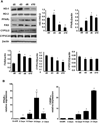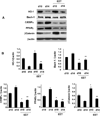Crosstalk between EET and HO-1 downregulates Bach1 and adipogenic marker expression in mesenchymal stem cell derived adipocytes
- PMID: 21821145
- PMCID: PMC3645487
- DOI: 10.1016/j.prostaglandins.2011.07.005
Crosstalk between EET and HO-1 downregulates Bach1 and adipogenic marker expression in mesenchymal stem cell derived adipocytes
Abstract
Epoxygenase activity and synthesis of epoxyeicosatrienoic acids (EETs) have emerged as important modulators of obesity and diabetes. We examined the effect of the EET-agonist 12-(3-hexylureido)dodec-8(2) enoic acid on mesenchymal stem cell (MSC) derived adipocytes proliferation and differentiation. MSCs expressed substantial levels of EETs and inhibition of soluble epoxide hydrolase (sEH) increased the level of EETs and decreased adipogenesis. EET agonist treatment increased HO-1 expression by inhibiting a negative regulator of HO-1 expression, Bach-1. EET treatment also increased βcatenin and pACC levels while decreasing PPARγ C/EBPα and fatty acid synthase levels. These changes were manifested by a decrease in the number of large inflammatory adipocytes, TNFα, IFNγ and IL-1α, but an increase in small adipocytes and in adiponectin levels. In summary, EET agonist treatment inhibits adipogenesis and decreases the levels of inflammatory cytokines suggesting the potential action of EETs as intracellular lipid signaling modulators of adipogenesis and adiponectin.
Copyright © 2011. Published by Elsevier Inc.
Figures






Similar articles
-
Epoxyeicosatrienoic acid agonist regulates human mesenchymal stem cell-derived adipocytes through activation of HO-1-pAKT signaling and a decrease in PPARγ.Stem Cells Dev. 2010 Dec;19(12):1863-73. doi: 10.1089/scd.2010.0098. Epub 2010 Oct 9. Stem Cells Dev. 2010. PMID: 20412023 Free PMC article.
-
Ablation of soluble epoxide hydrolase reprogram white fat to beige-like fat through an increase in mitochondrial integrity, HO-1-adiponectin in vitro and in vivo.Prostaglandins Other Lipid Mediat. 2018 Sep;138:1-8. doi: 10.1016/j.prostaglandins.2018.07.004. Epub 2018 Jul 21. Prostaglandins Other Lipid Mediat. 2018. PMID: 30041041 Free PMC article.
-
Increased heme-oxygenase 1 expression in mesenchymal stem cell-derived adipocytes decreases differentiation and lipid accumulation via upregulation of the canonical Wnt signaling cascade.Stem Cell Res Ther. 2013 Mar 12;4(2):28. doi: 10.1186/scrt176. Stem Cell Res Ther. 2013. PMID: 23497794 Free PMC article.
-
Epoxyeicosatrienoic acids and heme oxygenase-1 interaction attenuates diabetes and metabolic syndrome complications.Prostaglandins Other Lipid Mediat. 2012 Jan;97(1-2):1-16. doi: 10.1016/j.prostaglandins.2011.10.002. Epub 2011 Nov 15. Prostaglandins Other Lipid Mediat. 2012. PMID: 22100745 Free PMC article. Review.
-
Molecular Regulation of Adipogenesis and Potential Anti-Adipogenic Bioactive Molecules.Int J Mol Sci. 2016 Jan 19;17(1):124. doi: 10.3390/ijms17010124. Int J Mol Sci. 2016. PMID: 26797605 Free PMC article. Review.
Cited by
-
HO-1 Upregulation Attenuates Adipocyte Dysfunction, Obesity, and Isoprostane Levels in Mice Fed High Fructose Diets.J Nutr Metab. 2014;2014:980547. doi: 10.1155/2014/980547. Epub 2014 Sep 9. J Nutr Metab. 2014. PMID: 25295182 Free PMC article.
-
CYP2J2 targeting to endothelial cells attenuates adiposity and vascular dysfunction in mice fed a high-fat diet by reprogramming adipocyte phenotype.Hypertension. 2014 Dec;64(6):1352-61. doi: 10.1161/HYPERTENSIONAHA.114.03884. Epub 2014 Sep 22. Hypertension. 2014. PMID: 25245389 Free PMC article.
-
Humble beginnings with big goals: Small molecule soluble epoxide hydrolase inhibitors for treating CNS disorders.Prog Neurobiol. 2019 Jan;172:23-39. doi: 10.1016/j.pneurobio.2018.11.001. Epub 2018 Nov 14. Prog Neurobiol. 2019. PMID: 30447256 Free PMC article. Review.
-
Single-cell Transcriptomic Analysis Reveals the Cellular Heterogeneity of Mesenchymal Stem Cells.Genomics Proteomics Bioinformatics. 2022 Feb;20(1):70-86. doi: 10.1016/j.gpb.2022.01.005. Epub 2022 Feb 3. Genomics Proteomics Bioinformatics. 2022. PMID: 35123072 Free PMC article.
-
Heme Oxygenase-1 Upregulation: A Novel Approach in the Treatment of Cardiovascular Disease.Antioxid Redox Signal. 2020 May 10;32(14):1045-1060. doi: 10.1089/ars.2019.7970. Epub 2020 Feb 10. Antioxid Redox Signal. 2020. PMID: 31891663 Free PMC article. Review.
References
-
- Abraham NG, Kappas A. Pharmacological. clinical aspects of heme oxygenase. Pharmacol Rev. 2008;60:79–127. - PubMed
-
- Abraham NG. Molecular regulation—biological role of heme in hematopoiesis. Blood Rev. 1991;5:19–28. - PubMed
-
- Chertkov JL, Jiang S, Lutton JD, Levere RD, Abraham NG. Hemin stimulation of hemopoiesis in murine long-term bone marrow culture. Exp Hematol. 1991;19:905–909. - PubMed
Publication types
MeSH terms
Substances
Grants and funding
LinkOut - more resources
Full Text Sources
Medical
Research Materials
Miscellaneous

